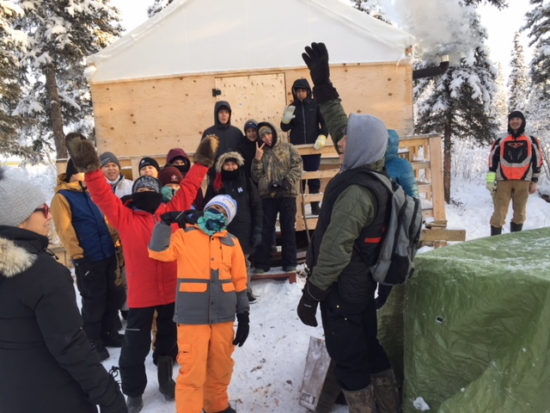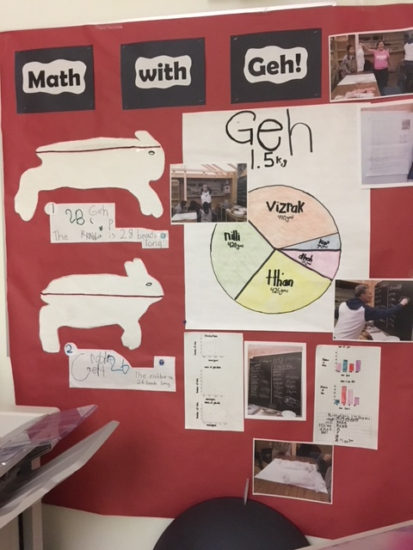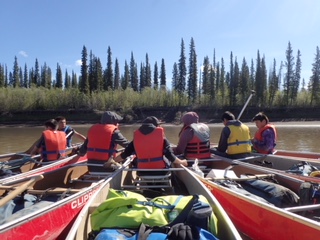Where culture, language and curriculum coalesce

Chief Paul Niditchie School (CPNS)
Tsiigehtchic, Northwest Territories
IN A NUTSHELL
At this remote Arctic school, authentic culture-based programming aligns with the seasonal activities of the Gwich’ya Gwich’in people. Learning moves seamlessly from the school’s indoor classrooms to land-based education on the traditional fishing, hunting, and trapping grounds surrounding the community. This wrap-around approach to Indigenizing education, which grounds curriculum in the ways of knowing, doing and being of the people, has been characterized as “reconciliation in action.” Leadership, resilience, land-based inquiry, language reclamation, reconciliation and cultural pride are key components of this program and help students find themselves in their educational journey.
THE SCHOOL COMMUNITY
Chief Paul Niditchie School (CPNS) is a Junior Kindergarten to Grade 9 school in Tsiigehtchic, Northwest Territories (NWT). The 33 students are all Indigenous to the region. Historically, the school’s students have struggled to engage with school, as they did not feel represented in the program of studies.
In the NWT, schools must both reflect and belong to the community. Reaching out to and including Elders and other traditional knowledge holders, parents of the students, and the community as a whole, is a fundamental aspect of the school’s approach.
Residential school resulted in NWT children being cut off from their language, culture, and way of life. This legacy is still strongly felt across the NWT and is seen as the root of many of the challenges in our northern communities today. It is evidenced in the broken relationships between many northern people and the formal, Western education system. By recognizing the community as the holder of traditional knowledge and inviting deep involvement from Elders, traditional knowledge holders, parents and other community members, Chief Paul Niditchie School has become a place where, in the words of Gwichya Gwich’in Council President Grace Blake, “people once again feel welcome and a part of their children’s learning experiences.”

PROGRAM DESCRIPTION
This whole-school program places the Gwich’ya Gwichin culture at the heart of the educational journey, with prescribed academic curricula layered into it. A number of key components make this possible:
Community cultural experts
The school recognizes the community as the holder of traditional knowledge. Local Indigenous staff are empowered as school experts and leaders. Elders and local resource people are engaged in planning/leading key cultural and land-based experiences for the school. Community members who practice traditional cultural skills are employed as support staff to work with at-risk students on land-based activities that provide country foods, support for Elders, and build leadership skills.
Curriculum grounded in Indigenous teachings
Student learning activities are planned based on the Gwich’in calendar and the seasonal cultural and subsistence activities of the people. Academic learning is integrated into these activities and academic classroom-based lessons celebrate traditional stories, knowledge and values. For example, creative writing projects have included two-voice poems from the perspective of hunter and prey, and short stories inspired by cultural experienced.
Land-based learning, fostering a deep connection to the land, is a vital component of the program. Annual hunting and canoeing trips on the Tsiigehnjik River are two comprehensive examples. A joint effort between local organizations in the community and CPNS, these trips empower youth to acknowledge and embrace their role as future stewards of this heritage river.
Language revitalization
Everyone in the school is involved in learning the Gwish’ya Gwish’in language. Key vocabulary is taught and used, and once a week Indigenous language speakers lead a language immersion program at the school camp.
Sharing with community
The community is welcomed into the school with celebratory feasts, where students share their learning and traditional knowledge is recognized and valued.

TEACHER AND STUDENT ENGAGEMENT
Of the school’s six teachers, only one is Indigenous. This means teachers are learning alongside the students and they have embraced this challenge with enthusiasm and commitment. Students, staff, and community members are all engaged in meaningful cultural traditional practices and as equal partners in education. Inspired by their learning, the teachers have initiated collegial lunches to celebrate and reflect on their successes and challenges in Indigenizing practice. They also initiated a community radio program celebrating the Gwich’in language and inviting parents to participate in their children’s learning.
CPNS has seen increased student engagement and improved academic results, emotional well-being and resilience through this holistic Indigenized program. One example: as part of land-based learning, students have re-engaged with drumming, a traditional practice that was all but lost with colonialism. Student now request to learn and perform drum songs in the language as part of our celebrations, demonstrating their stewardship, spiritual connection and engagement. Frank Galway, Superintendent f Beaufort Delta Education Council, notes, “We are consistently seeing CPNS students emerge as confident, capable people able to walk in two worlds with their heads held high and their hearts grounded in their cultural values.”
INNOVATIVE VALUE/NEXT STEPS
Chief Paul Niditchie School places Indigenization at the heart of the school’s program, rather than sprinkling it on top of a conventional Western academic approach. Its interwoven components of collaboration with local cultural experts, land-based learning, language revitalization and community inclusion have not only benefitted the students but changed the relationship between school and community.
Other schools in the district have expressed interest in CPNS’s model. With the proviso that education rooted in place and culture is fundamental to Indigenous ways of knowing, many elements of the program are scalable and could be adapted and adopted by schools in other communities.
Related learning
School blog with photos of land-based learning and integration with math curriculum
Related EdCan content
Articles
The Red Worn Runners: Intentional conversations with Indigenous youth
Of Orcas and Learning on the Land: CAILBE and the revitalizing of Indigenous, land-based learning
Teaching the Tension: Indigenous land rights, activism, and education in Canada
Our Journey Into Reconciliation: A Project of Heart at Stavely Elementary School
Stavely Elementary School’s Project of Heart: A Blackfoot insight
Truth and Reconciliation, K-12: Becoming a teacher ally
Research and report
A guide on how urban high schools can raise Indigenous graduation rates
Reconciliation in Action: Creating a Learning Community for Indigenous Student Success
Fact Sheet
Infographic
How teachers can integrate Truth and Reconciliation in their classrooms
Infographic: How to get started and who can help
